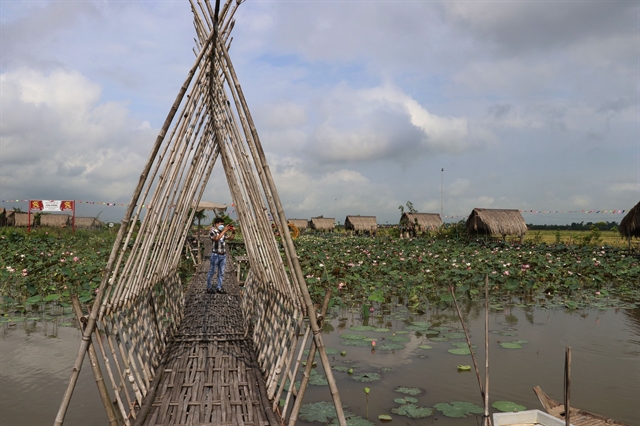 Society
Society

 |
| A lotus field is a tourism attraction in Đồng Tháp Province’s Tháp Mười District. – VNA/VNS Photo Nguyễn Văn Trí |
ĐỒNG THÁP – To improve the income of lotus farmers in Đồng Tháp Province, it is necessary to expand cultivation scale, standardise growing areas and deeply process the flowers, experts have said.
The country’s largest lotus producing locality, situated in the Cửu Long (Mekong) Delta, grows the flower on 258ha, mostly in Tháp Mười, Cao Lãnh, Tam Nông, and Thanh Bình districts.
The flower fetches farmers an average income of VNĐ116 million (US$5,000) per hectare per year.
It is used as food, medicine and ornaments and serves as a tourist attraction.
Speaking at a seminar held in the province last week, Ngô Chí Công, chairman of the province Association of Lotus, said having standard growing areas and stable output are imperative for making quality products.
However, he said, only a small portion of the province’s lotus growing areas have standard certificates.
The province has favourable soil and weather conditions for growing the flower year round, but, without zoning for each season, the quality and output are not even, he said.
The province should zone separate areas for various parts of the flower like seeds, roots, leaves, and flowers, he added.
Phạm Minh Nhựt, head of the HCM City Technology University’s Bio-technology Faculty, said all parts of a lotus plant are home to various biological activities, including antioxidant and antibacterial, which could be used by the cosmetics industry.
Natural cosmetics are made from extracting the essence of flowers, fruits and minerals, and lotus contains many natural nutrients, he said.
“One of the plants with great potential for use in cosmetic production is the lotus.”
Lê Trung Hải, former director of the 103 Army Hospital, said all parts of the lotus plant are very good for health.
The leaves could be used to treat diarrhea, fever, obesity, pain, and microbial infections, and the root and stem as diuretics and sedatives and for diabetes prevention, he said.
But added value for lotus is only initial processing and there are few products made using sophisticated technology, he said.
"Added value in health, nutrition and cosmetic products has not been effectively exploited yet."
Minister of Agriculture and Rural Development Lê Minh Hoan said the cultural and spiritual values of the lotus should be further exploited.
It should not be only about selling lotus products but also about the story of the lotus, he said.
Linkages in producing, processing and consuming are essential for the sustainable development of lotus, he said.
Lê Quốc Điền, deputy director of the province's Department of Agriculture and Rural Development, said the linkage between farmers and companies is at the core of sustainably developing lotus farming.
“The department has obtained new lotus varieties from South Korea and Japan and will reproduce their seedlings and supply to farmers.”
It is working with the Department of Science and Technology to apply advanced techniques to making lotus products, he added.
The department has called on the Fruit and Vegetable Research Institute (FAVRI) to develop a lotus development plan for the province for 2021-25 period.
Đặng Văn Đông, deputy head of FAVRI, said the plan targets increasing the lotus growing area to 1,400ha in 2025, and achieving an average yield of 0.9 – 1.2 tonnes of dried seeds per hectare per year.
The total annual income from the flower is expected to be VNĐ400 - 500 billion ($17 – 21 million) in 2025.
The plans seeks to create lotus value chains and geographical indication by 2025.
The province will have 7 – 10 concentrated lotus growing areas that apply advanced techniques and adopt good agricultural practices by 2025. – VNS




